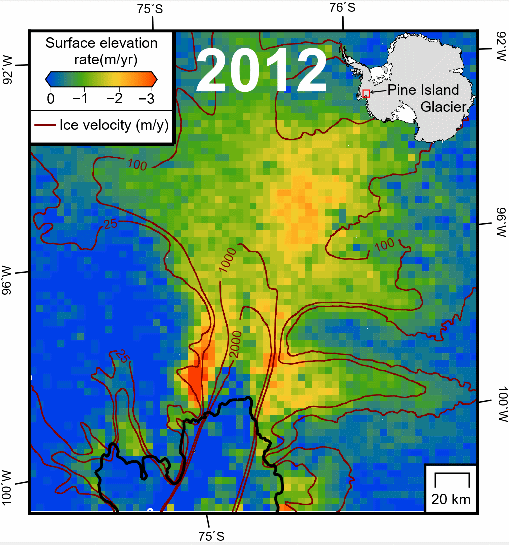29.01.2020

Ice loss from Pine Island Glacier has contributed more to sea-level rise over the past four decades than any other glacier in Antarctica. However, the way this huge glacier is thinning is complex, leading to uncertainty about how it is likely to raise sea level in the future. Thanks to ESA’s CryoSat mission, scientists have now been able to shed new light on these complex patterns of ice loss.
Although Pine Island Glacier is one of the most intensively and extensively investigated glacier systems in Antarctica, different model projections of future mass loss give conflicting results; some suggesting mass loss could dramatically increase over the next few decades, resulting in a rapidly growing contribution to sea level, while others indicate a more moderate response.
Identifying which is the more likely behaviour is important for understanding future sea-level rise and how this vulnerable part of Antarctica is going to evolve over the coming decades.
In a paper published in Nature Geoscience, scientists from the University of Bristol, UK, describe how they used information from CryoSat to help clarify the situation. They discovered that the pattern of ice loss is evolving in complex ways, both in space and time.

Rates in the fast-flowing central trunk of the glacier have decreased by about a factor of five since 2007 – and this is the opposite of what was observed prior to 2010.
These new results suggest that rapid migration of the grounding line, the place where the grounded ice first meets the ocean, is unlikely over the next decades, without a major change in the role of the ocean in ice loss. Instead, the results support model simulations that imply that the glacier will continue to lose mass, but not at much greater rates than present.
Lead author Prof. Jonathan Bamber from the University of Bristol’s School of Geographical Sciences, said, “This could seem like a ‘good news story’, but it’s important to remember that we still expect this glacier to continue to lose mass in the future and for that trend to increase over time, just not quite as fast as some model simulations suggested.
“It’s really important to understand why the models are producing different behaviour in the future and to get a better handle on how the glacier will evolve with the benefit of these new observations.
“In our study, we didn’t make projections, but with the aid of these new data we can improve model projections for this part of Antarctica.”
Tommaso Parrinello, ESA’s CryoSat mission manger, added, “In April, CryoSat will have been in orbit for 10 years, far exceeding its expected life. We continue to be proud of the contribution to science this extraordinary satellite mission is making.
“And here, with the issue of sea-level rise a major global concern, the better equipped we are with facts the better it is. CryoSat has helped clarify the situation at Pine Island Glacier, which is not only important for our scientific understanding, but ultimately for society at large.”
Quelle: ESA
